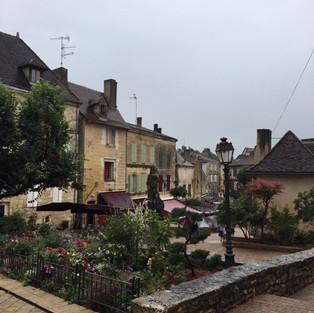The Fairy-tale Region of France
- Lisa Colletta

- Nov 10, 2019
- 3 min read
Updated: Apr 17, 2020

The French regions of Armagnac and Cognac are beautiful, but the Périgord is place that conjures up fairy tales. With its small villages, large chateaux, and fields of sunflowers, the Périgord has become one my favorite corners of France.
The beautiful towns of Sarlat, Périgueux, Bergerac, and Le Bugue are some of the most enchanting places I have been. For the most part, the centers of these villages have not changed much from the 14th century, and the stone buildings and slate roofs have the look of an illuminated manuscript. The Périgord has been occupied continually for 70,000 years, soaked in history and deeply reflective of human experience. The Neanderthals hunted in the forests, and very early modern man created mysterious masterpieces in the caves of Lascaux. The Moors were here, too, from 600 to about 750, and then the Vikings.
While this area was off the beaten track of the Grand Tour, the British have always been drawn to the Dordogne (the department that includes the Périgord), which they ruled until being ejected from France in the 15th century at the end of the Hundred Years’ War. It seems impossible to definitively eject the British from Europe--though they appear insistent on ejecting themselves--so in the summer months the place is awash with English. They often travel in packs, loaded up on buses, but if one takes her time, driving leisurely from town to town, ferreting out the region’s chateaux with four or five bedrooms for guests, it is possible to avoid them.

Thankfully, the region is also awash in duck fat, and, say what you want to about fois gras and pâté, there is nothing better smeared on a piece of crusty bread with a glass of Château de Lestevenie Côte de Bergerac Rouge (sorry, New Yorkers). The region’s wines are not much esteemed, even though it is just an hour from Bordeaux, but it is possible to find a few good producers. This state of affairs is partly due to the fact that after the phylloxera aphid destroyed much of France’s grapevines in the 19th century, then leaders of the Périgord decided that tobacco was the future and urged farmers not to replant the grapevines. That crop is now on the wane, and in this still largely agricultural part of France, they have returned to history and the cultivation of wine, walnuts, cheeses, and mushrooms. There are also, of course, the black truffles, elevating everything from the humble egg or a chicken breast to the heights of gastronomic bliss.
I happen to be a fan of the “Bruno, Chief of Police” mysteries by Martin Walker, who sets his novels in the fictional town of St. Denis in the Périgord. Much like the Sicily of Andrea Camilleri’s Montalbano novels, the Périgord in the Bruno novels has the presence of a character. The spirit of place is rich in his fiction, and his books are full of atmosphere and characters who are both confined and enriched by history and memory. Like Montalbano, Bruno is always attentive to the importance and pleasure of a good meal as he combats murderers, terrorists, archaeological thieves, and truffle fraudsters. But for Bruno, as for any good detective, merely solving the crime doesn't solve the deeper problem. More often than not, Bruno's real antagonists are the officious bureaucrats who threaten the way of life that for centuries has made the Périgord such a magical place.










Comments